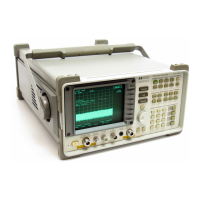Line Fuse Blowing
1. If the line fuse blows with the (LINE) switch off, suspect either the Input Filter or the power
switch cable assembly.
2. If the line fuse blows when the HP 8560A is turned on, disconnect the power cord and lift
the drain of A6QlO2 from TP108. If the line fuse still blows, suspect
U102.
3. If the fuse is working properly, check
A6TP108
for a voltage of between
+215
V and
+350
v.
4. If the voltage at TP108 is correct, disconnect the power cord; remove and check A6QlO2.
5. If
QlO2
is shorted, Q103, Q104, CR106, and CR108 are also probably shorted. If Q102 is
working properly, measure the resistance between TP102 and
TPlOl
(positive ohmmeter
lead to
TPlO2).
6. If the resistance is less than 1
kR,
suspect either Q103 or
Q104
in the DC-DC Converter.
Supply Restarting Every 1.5 Seconds (Kick Start)
See function blocks G and L of A6 Power Supply Schematic Diagram in the Component- Level
Information binder.
If there is a short on the power supply or on one of the other assemblies, the power supply will
attempt to “kick start.”
(Every 1.5 seconds the supply will attempt to start, but will be shut
down by a fault condition.) The Kick Start and Bias circuits provide power for the control
circuitry during power-up. The Kick Start circuitry is an RC oscillator which emits a 200 ms
pulse every 1.5 seconds. These pulses switch current from the Input Rectifier through
Q201
to
charge C201. When the power supply is up, a winding on T103 provides power to the control
circuitry. This voltage is high enough to keep
Q201
turned off.
1. Monitor the waveforms at TP206 and TP208 simultaneously on an oscilloscope.
2. If the signal at TP208 goes high before the signal at TP206 goes low, an overcurrent
condition has been detected. Suspect a short in the secondary (Output Rectifier, Voltage
Regulators, or another assembly).
Low Voltage Supplies
1. Connect the DVM’s negative lead to
A6TP301.
2. Check
A6TP302
for
+15
Vdc.
3. Check
A6TP303
for -15 Vdc.
4. Check
A6TP304
for
f28
Vdc.
5. Check
A6TP305
for -12.6 Vdc.
6. Check
A6TP308
for
+5
Vdc.
7. If the voltages measured above are correct but the power supply LEDs on the A2
Controller Assembly are not lit, check
Wl.
8. If the voltages are low, disconnect
Wl
from
A6Jl
and measure the test point voltages
again. Unless a dummy load is connected to the A6 Power Supply, the voltages should
return to their nominal voltages but be unregulated.
Display/Power Supply Section 12-13

